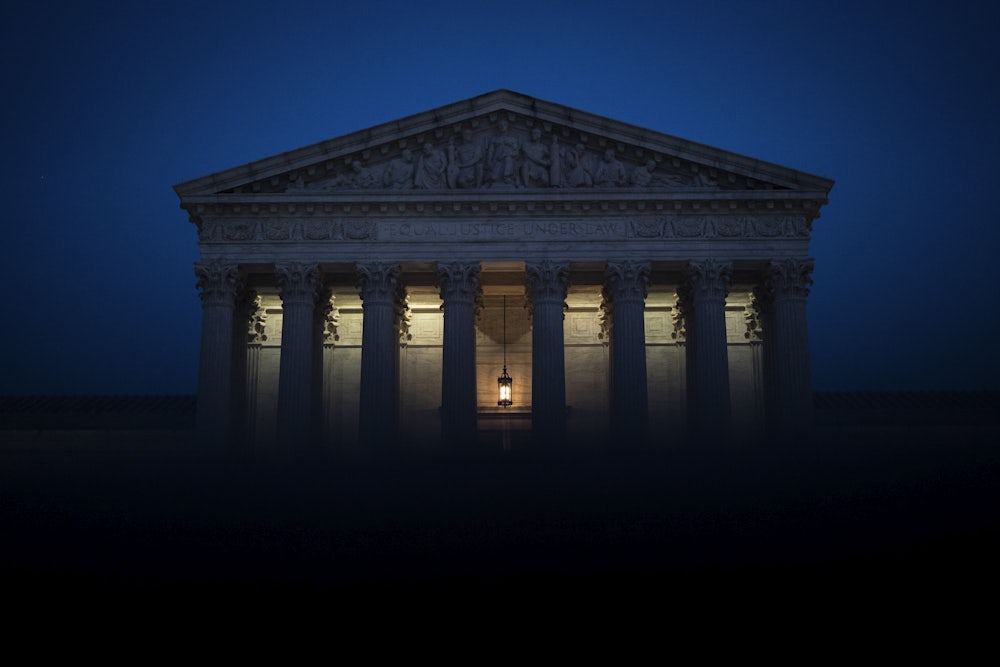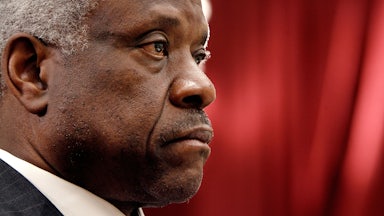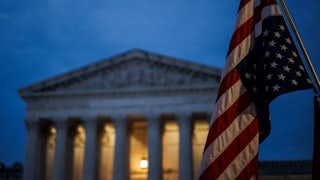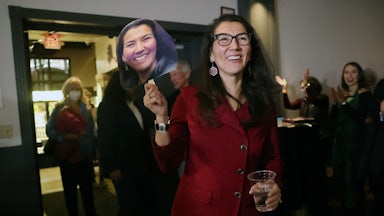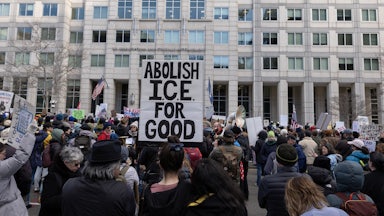The Supreme Court’s summer vacation ends in three weeks. For some of the justices, it was not an entirely restful one. Two of the court’s liberal members have warned in unmistakable terms that the court’s recent actions have led it to a legitimacy crisis of sorts. “Each time the court upends precedent, it does create discomfort in the society,” Justice Sonia Sotomayor warned at a California lawyers’ event earlier this month. “I think there’s an innate understanding, or at least expectation, that law itself will be stable and not subject to political influence,” she said. “When the court does upend precedent, in situations in which the public may view it as active in political arenas, there’s going to be some question about the court’s legitimacy.”
Justice Elena Kagan raised similar concerns during a Rhode Island event this month. “The court shouldn’t be wandering around just inserting itself into every hot button issue in America, and it especially, you know, shouldn’t be doing that in a way that reflects one ideology or one set of political views over another,” she explained to the audience. Though neither Kagan nor Sotomayor mentioned their conservative colleagues by name, it was not hard to deduce to whom they were referring.
Their warnings are borne out by public opinion surveys conducted by three of the most reliable polling organizations on Supreme Court issues. Taken together, they show a clear and unambiguous shift in how the American people perceive the court since it overturned Roe v. Wade this summer—and a growing willingness to rein in the justices’ ideological shift. If that backlash among the public proves durable, and if the Supreme Court’s conservative majority does not change tack, some sort of confrontation between the two forces may be inevitable.
On June 23, Gallup found that only 25 percent of Americans said that they had either a great deal of confidence or quite a lot of confidence in the high court. That represented a 5 percent drop from the previous low in 2014, as well as a 10 percent decline from the 2021 survey. The Gallup poll technically preceded the release of the court’s decision in Dobbs on June 24. But it came more than a month after Politico published a draft copy of Justice Samuel Alito’s majority opinion in the case, which all but proved that the court would overturn Roe later that month.
Next came a survey by the Pew Research Center on September 1. It incorporated the entire period after Dobbs’s release and found an even deeper shift in public opinion about the Supreme Court in three significant ways. First, it found that the court’s overall favorability ratings were underwater for the first time since it began asking Americans in 1987, with 49 percent of Americans viewing the court unfavorably and 48 percent favorably. That was a sharp reversal from two years ago when 70 percent of Americans said they viewed the court favorably and 28 percent said they didn’t. In essence, nearly a third of Americans have changed their mind about the Supreme Court over the past two years.
Which segment of Americans changed their minds? Pew’s second notable finding was the emergence of a major partisan divide in how people view the court. While 67 percent of Democrats described themselves as favorable in 2020, only 28 percent said the same thing in 2022. Republican support, by comparison, clocked in at 73 percent. The Supreme Court has seen other sharp partisan changes in its public perception in recent years. Republican support briefly dipped to 33 percent in 2015, the year that the justices struck down same-sex marriage bans and turned back right-wing litigation on abortion rights and affirmative action, before rebounding during the Trump era. But the post-Dobbs drop among Democrats stands out for both the size and the speed of the decline.
The third notable finding from Pew was a growing sense that the Supreme Court as an institution had grown too strong. Only 25 percent of Americans said in 2020 that the justices had too much power. That number jumped to 45 percent after Dobbs, with only a 3 percent gap separating them from those who were fine with the status quo. Here Pew also found a partisan divide and a surging sense of dissatisfaction on the left: 23 percent of Democrats said they supported court-packing the Supreme Court in 2020, when the question was already circulating among some Democratic officials and liberal commentators. After Dobbs, that number rose to 64 percent.
Marquette Law School’s most recent survey about the high court, which was published this week, again revealed a sharp decline in public support for the justices. It found that the court went from a 66 percent/33 percent approval/disapproval rating among all Americans two years ago to just 40 percent/60 percent today. The causal factor was again obvious, as Marquette found that roughly two-thirds of Americans disapproved of the Dobbs ruling. But the real humdinger was buried in the crosstabs: 51 percent of Americans said that they either strongly or somewhat supported expanding the Supreme Court, including a bare majority of self-described independents. To my knowledge, this is the first reputable Supreme Court pollster to find majority support for that proposal, even if it is a bare majority at that.
At this point you might be asking, “So what?” These numbers would be calamitous for the court’s conservative justices if they were on the ballot in this fall’s midterm elections. But they are not and they never will be. And, indeed, there is an argument to be made that the Supreme Court is not supposed to be responsive or even sensitive to public opinion. It is, at least in theory, a court of law that is supposed to impartially decide cases and not an elected body with constituents to satisfy and voters to woo.
If the polls merely showed that Americans were mad at the Supreme Court, then it might be easier to overlook. But the post-Dobbs surveys also reveal that a clear plurality of Americans—and perhaps even a majority of them—are pairing that anger and frustration with a desire for institutional reform, particularly among Democrats. Whether this desire will persist in the long run or fade as time separates the country from the moment that Roe was overturned is impossible to predict. But for now, the desire undeniably exists.
For what it’s worth, I suspect that this urge will not fade immediately. Dobbs had immediate consequences for millions of Americans across the country, particularly in the Midwest and the South where a series of total or near-total bans snapped into place. The results of those bans have already drawn an intense backlash of their own. Abortion rights will remain an active political issue as state legislators and officials in places like Indiana, Michigan, and Wisconsin debate what comes next for their people in a post-Roe world. And even in the states where no legislative action is imminent, recent GOP proposals to pass a 15-week ban in Congress will ensure that abortion rights will play a major role in this fall’s midterm elections for all Americans.
Roe was somewhat unique in the firmament of Supreme Court decisions that Americans deeply care about. It is one of a scant few cases, along with Brown v. Board of Education and perhaps Dred Scott v. Sandford, that can be freely mentioned without having to describe the underlying details of the case. At the same time, the Supreme Court will have more opportunities in the upcoming term to touch raw nerves in American political life. In the next few months, the court will hear oral arguments on whether it should bar any consideration of race or diversity in college admissions, and the likeliest answer from the conservative majority will be “no.” The justices will also get yet another opportunity to narrow or gut the Voting Rights Act of 1965 when it hears a racial gerrymandering case from Alabama this fall. If Justice Clarence Thomas gets his way, major precedents on everything from same-sex marriage to contraceptive access could be “revisited.”
Chief Justice John Roberts famously said during his confirmation hearing in 2005 that the Supreme Court justice’s role is akin to that of an umpire at a baseball game who simply calls balls and strikes. That comparison is not quite accurate, at least for him and his eight co-workers. It is fairly true for lower court judges, who, like umpires, have little to no say about which cases or at bats they must consider. But the Supreme Court’s docket is almost entirely discretionary, which allows for an ideological majority on the court to essentially choose how it will reshape the law and the Constitution.
When the court agreed to take up Dobbs, for example, there was no split among the circuit courts of appeal to resolve, or muddled decision by an appeals court to clarify, or major undecided question of constitutional law to answer. There was only a 50-year push by the conservative legal movement that wanted to overturn Roe and a realization by the conservative justices that they had the five votes necessary to do it. The college admissions cases that will be heard this term also came about without a circuit split or a major change in the law. They are mainly the product of one right-wing legal activist who has tried, so far unsuccessfully, to overturn the Supreme Court’s precedents on the matter for more than a decade. Imagine if a Boston-born umpire went out of his way to call balls and strikes by the Red Sox’s division rivals.
The terminology that we use to describe this situation—a crisis of legitimacy, a loss of prestige and authority, a decline in popularity, or something else—matters less than its practical implications. The Supreme Court has shown little to no interest in not taking up cases that resolve major political issues in the conservative legal movement’s favor, even if it is out of step with public opinion. A strong plurality (and perhaps even a narrow majority) of the American people is not only unsatisfied with this trend, but is also increasingly supportive of proposals that would prevent or reverse it. Eventually, one of these sides will have to win or give way.
